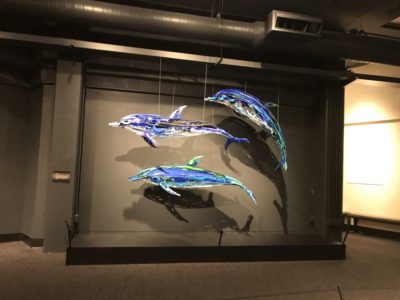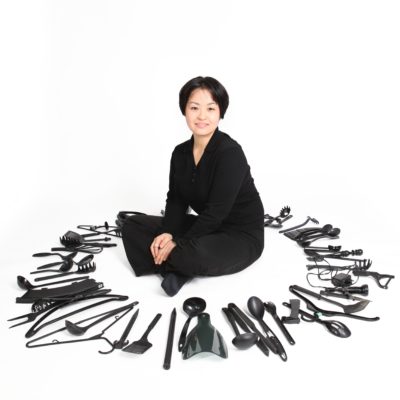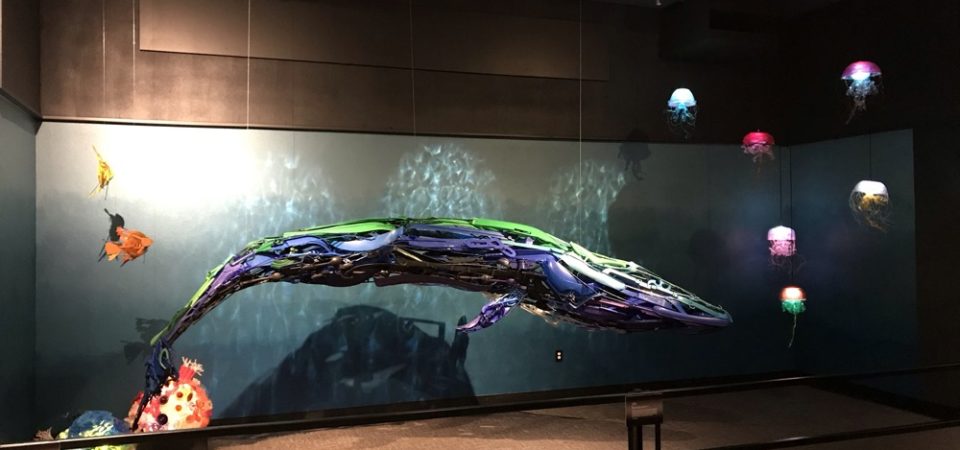By now we probably have all heard about how there’s so much plastic debris in the ocean that all the sea animals are ingesting small and sometimes not so small pieces of plastic. So we are aware that there are many pieces of plastic inside a whale. But did you know that there’s also a whale inside the plastic objects? I see an element inside some of the plastic objects that resonate with the form and energy of a whale. That’s what I look for when I’m making a sculpture of a whale.
I imagine a large whale swimming in the ocean. I imagine being this whale. When I breathe, my breath travels inside the body of this whale. Then I visualize the shape of this breath. Breath becomes a brushstroke. When I look at the plastic objects in front of me, I look for a shape that is similar to the brushstroke I visualized. When my eyes follow the shape, I try to feel for the breath moving through the whale. There must be a line that starts on the outer surface of the whale, then travels to the space inside the body, then exits through the other side. This does not necessarily occur where the respiratory organs are anatomically located in the body of the whale, but more in the imagined lines, like how people feel for breath traveling through different parts of the body in Yoga and other meditation techniques. If it becomes too crowded with brushstrokes inside the whale’s body that it looks like the energy is stagnant, I remove a few items that are blocking the flow. The first few plastic items that I attach on an animal sculpture almost always need to be removed later on.

Next, I think about water moving against the smooth aerodynamic curve of the whale’s back and look for the same curve in a sled or a ski. I describe the gentle bulge of the belly with a sliced section of a baby bathtub. I describe the silhouette of the whale from many angles until I can walk all the way around the sculpture and the form looks complete, but here again if I fill the outer surface to the point where it looks like the breath cannot flow in and out, I have to clear the passage by removing a few items. Removing an item that is blocking the flow of energy, especially later in the process, is even more important than adding an item to better describe the form.
There was a time in history when all the people thought that plastic was this amazing new material that could vastly improve our lives. The same exact qualities that made the plastic so attractive then, are now the central problem in plastic pollution which makes it one of the most hated materials. What seemed like the greatest technological invention also embodied dark consequences. Can it be possible that the reverse is also true? Even inside of something as mundane and toxic as a piece of plastic, there is an essence of great beauty that can be discovered if we are willing to use our imagination and shift our perspective.
I do not intend to directly address plastic pollution with my art, except to highlight the many different truths embodied by the plastics. Yes, there are immeasurable amounts of plastic waste in our oceans. Yes, plastics can be quite beautiful and wonderfully versatile. Yes, we need to produce less plastic objects. Yet, there are still many things most of us are not ready or able to give up that are made of plastic.
The art that I both want to make and love to see most from other artists are ones that can take my breath away with their beauty. This kind of art helps the viewers feel more open by engaging their sense of curiosity and wonder. Visual harmony can give a sense of trust that there is some sort of order in the world. For us to be willing to look at any issue from a different perspective, to start a new conversation, we need to first be able to trust. I want my art to be healing because when we are busy fighting pain and defending our wounds, it is very difficult to be kinder toward other beings. In the end, I believe that the beauty of my work will help the environmental cause more than any workshops I could host or carefully worded lectures. Viewers can drop their guard, and find that they can extend their empathy and compassion further out than they were previously willing to.
Sounding Who We Are – Audiofile
I think that many of us who are environmental activists and artists get so busy focusing on how terrible human beings are. But it’s very important to take a break from that every now and then and remember our innocence and innate goodness we also possess. So I wanted to share this with you as well as the people at MAHB:
 Sayaka Ganz was born in Yokohama, Japan and grew up living in Japan, Brazil, and Hong Kong. She received a Bachelor of Fine Arts degree at Indiana University Bloomington and continued to create welded sculptures of animal forms independently. In 2008 she received a Master of Fine Arts degree in sculpture from Bowling Green State University (BGSU) in Bowling Green, Ohio. She taught design and drawing courses at Indiana University – Purdue University Fort Wayne between 2002 and 2012. Using reclaimed plastic objects as materials, Sayaka’s recent sculptures depict animals in motion with rich colors and energy. She describes her style as “3D impressionist”, creating an illusion of solid form using plastic objects as brush strokes that become visible upon observation from close proximity. Her recent exhibitions include: “Danze Della Natura” – solo exhibition at the Hermann Geiger Foundation in Cecina, Italy, and “Feng Shui ~ Wind and Water” – solo exhibition in the Isle Gallery, Isle of Man, and “Changing Tides” – solo exhibition at the Foellinger-Freimann Botanical Conservatory in Fort Wayne, Indiana. Her recent commissions include a series of four marine life sculptures for the Monterey Bay Aquarium in California and a permanent installation depicting an underwater scene with right whale and various schools of fish in the atrium of the Exploration Tower in Port Canaveral, Florida.
Sayaka Ganz was born in Yokohama, Japan and grew up living in Japan, Brazil, and Hong Kong. She received a Bachelor of Fine Arts degree at Indiana University Bloomington and continued to create welded sculptures of animal forms independently. In 2008 she received a Master of Fine Arts degree in sculpture from Bowling Green State University (BGSU) in Bowling Green, Ohio. She taught design and drawing courses at Indiana University – Purdue University Fort Wayne between 2002 and 2012. Using reclaimed plastic objects as materials, Sayaka’s recent sculptures depict animals in motion with rich colors and energy. She describes her style as “3D impressionist”, creating an illusion of solid form using plastic objects as brush strokes that become visible upon observation from close proximity. Her recent exhibitions include: “Danze Della Natura” – solo exhibition at the Hermann Geiger Foundation in Cecina, Italy, and “Feng Shui ~ Wind and Water” – solo exhibition in the Isle Gallery, Isle of Man, and “Changing Tides” – solo exhibition at the Foellinger-Freimann Botanical Conservatory in Fort Wayne, Indiana. Her recent commissions include a series of four marine life sculptures for the Monterey Bay Aquarium in California and a permanent installation depicting an underwater scene with right whale and various schools of fish in the atrium of the Exploration Tower in Port Canaveral, Florida.
The MAHB Blog is a venture of the Millennium Alliance for Humanity and the Biosphere. Questions should be directed to joan@mahbonline.org
The views and opinions expressed through the MAHB Website are those of the contributing authors and do not necessarily reflect an official position of the MAHB. The MAHB aims to share a range of perspectives and welcomes the discussions that they prompt.
